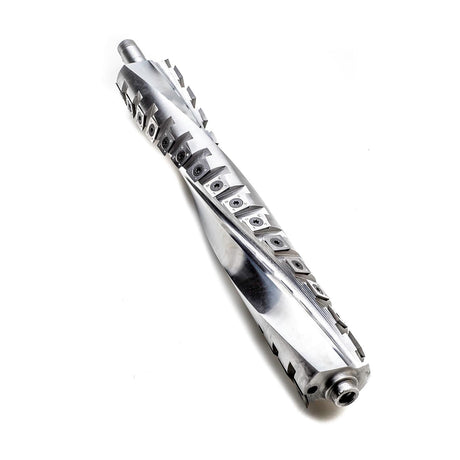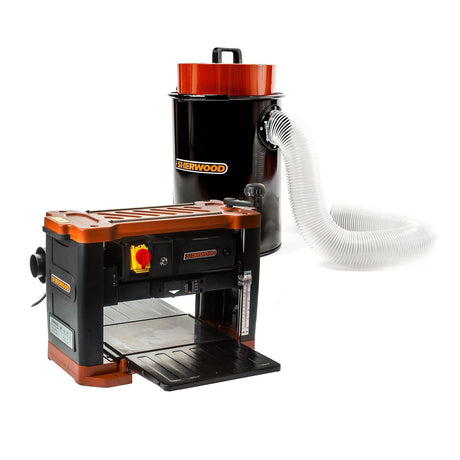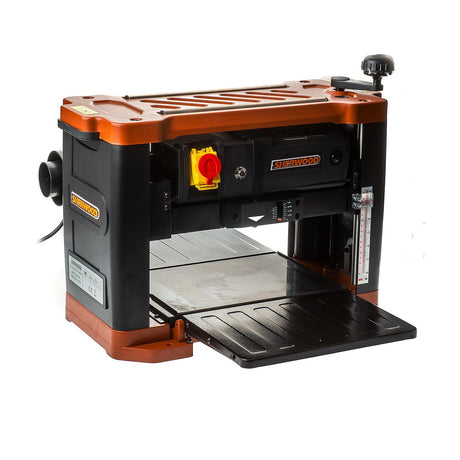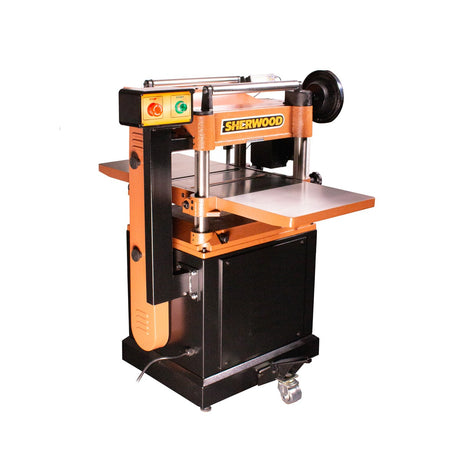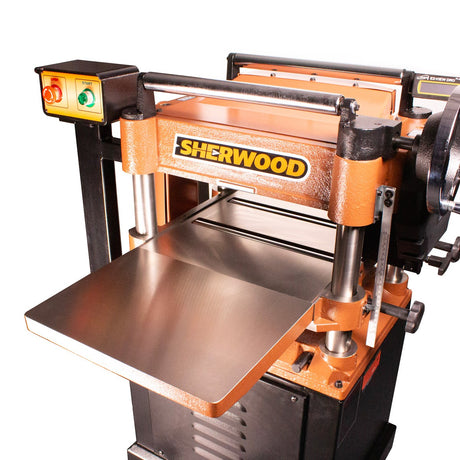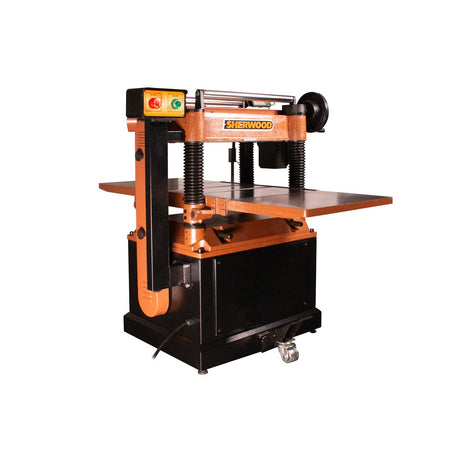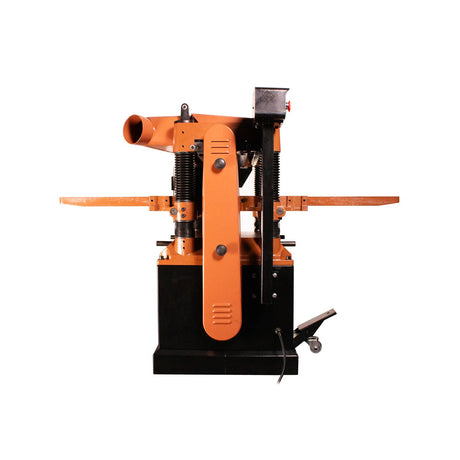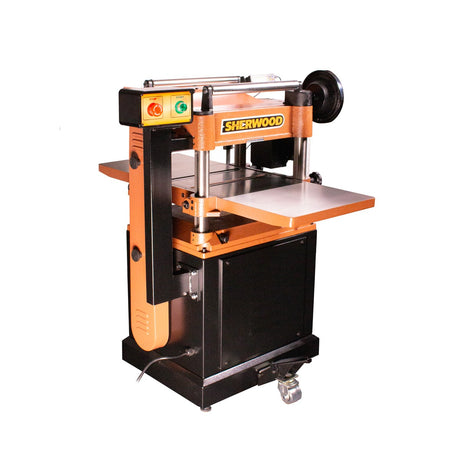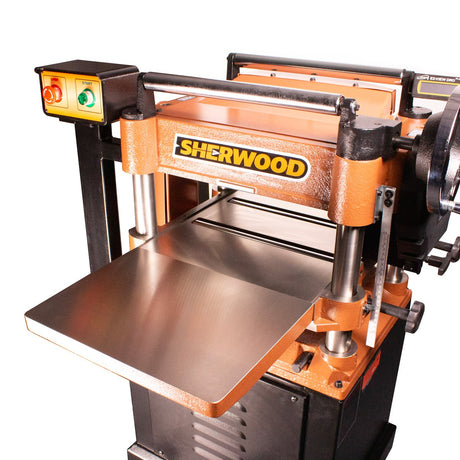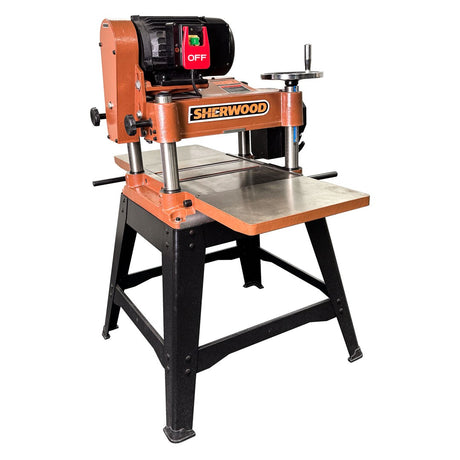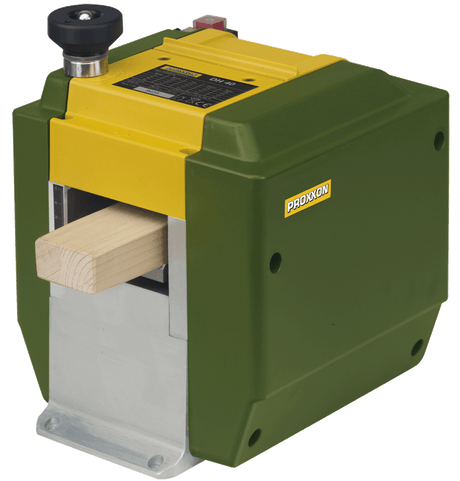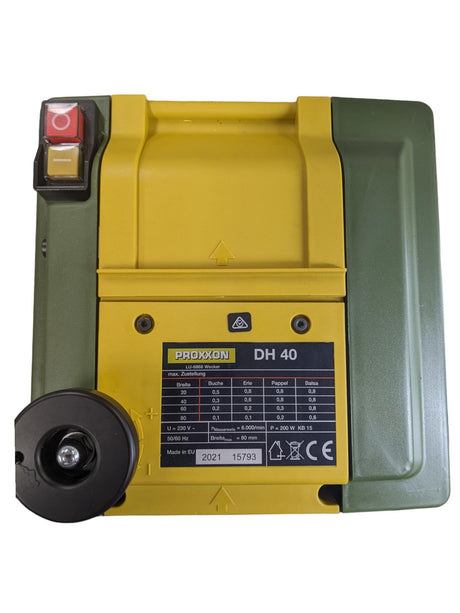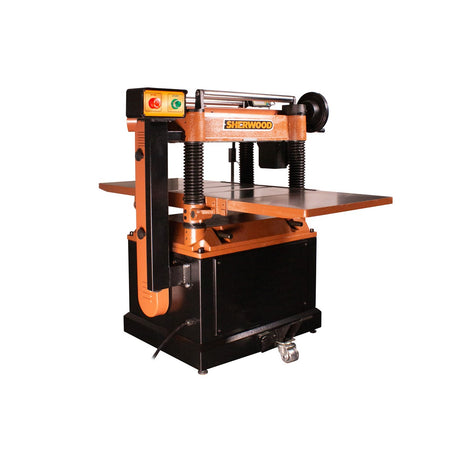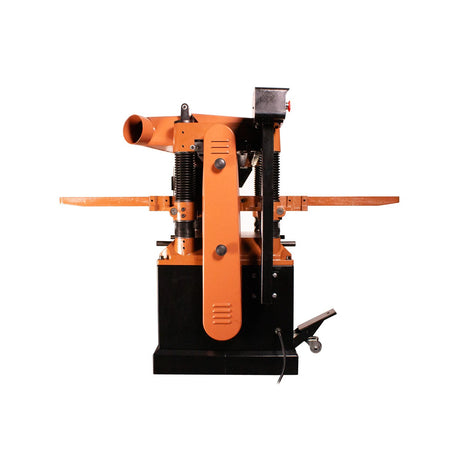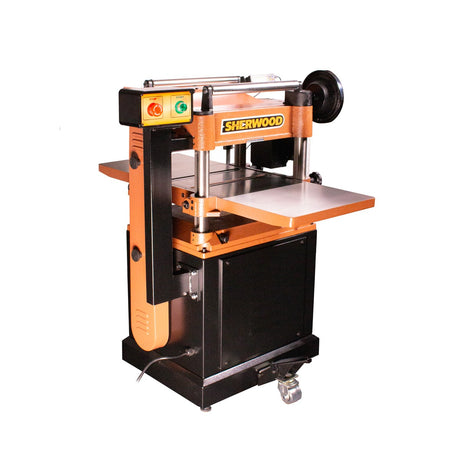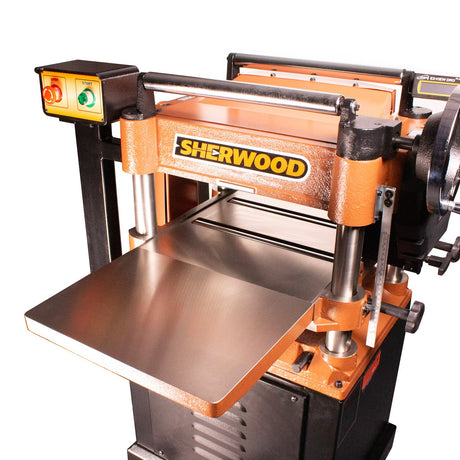Sherwood
Sherwood 13in Deluxe Benchtop Thicknesser with Helical Cutterhead 1500W 2HP
$1,079.00$1,199.00Unit price /UnavailableIn stockSherwood
Sherwood 13in Benchtop Pro Thicknesser with Helical Cutterhead 1800W
$1,349.00$1,499.00Unit price /UnavailableIn stockSherwood
$1,279.00$1,428.00Unit price /UnavailableIn stockSherwood
Sherwood 16in Industrial Thicknesser Helical Cutterhead Single Phase 2200W 3HP
$3,749.00$4,099.00Unit price /UnavailablePre-OrderSherwood
Sherwood 13in Benchtop Thicknesser with Straight Blade Cutterhead 1500W 2HP
$599.00$679.00Unit price /UnavailableIn stockSherwood
Sherwood 20in Industrial Thicknesser Helical Cutterhead Single Phase 3750W 5HP
$5,399.00$5,799.00Unit price /UnavailablePre-OrderSherwood
Sherwood 16in Industrial Thicknesser Straight Cutterhead Single Phase 2200W 3HP
$1,999.00$2,699.00Unit price /UnavailableSherwood
Sherwood 15in Heavy-Duty Portable Thicknesser 2200W 3HP with Helical Head
$3,399.00$3,699.00Unit price /UnavailableVery low stock (1 unit)PROXXON
PROXXON DH-40 Micro Thicknesser 80mm 200W Straight Blade
$1,349.90Unit price /UnavailableIn stockSherwood
Sherwood 20in Industrial Thicknesser Helical Cutterhead Three Phase 3750W 5HP
$5,499.00$5,999.00Unit price /UnavailableSherwood
Sherwood Benchtop Planer Bundle with Straight Blade Cutterhead Plus DC-50 Extractor
$1,330.00$1,407.00Unit price /UnavailableSherwood
Sherwood 16in Industrial Thicknesser Helical Cutterhead Three Phase 2200W 3HP
$3,849.00$4,199.00Unit price /UnavailableVery low stock (1 unit)Sherwood
Sherwood 15in Heavy-Duty Portable Thicknesser 2200W 3HP
$1,875.00$2,499.00Unit price /UnavailableSherwood
Sherwood Deluxe Benchtop Planer Bundle with Helical Cutterhead Plus DC-50 Extractor
$2,449.00$2,577.00Unit price /UnavailableIn stockSherwood
Sherwood Pro Benchtop Planer Bundle with Helical Cutterhead Plus DC-50 Extractor
$2,899.00$3,077.00Unit price /UnavailableIn stockSherwood
$4,124.00$5,499.00Unit price /UnavailableVery low stock (1 unit)
Thicknessers
When precision in woodwork matters, a reliable thicknesser is indispensable. Timbecon offers some of the best thicknessers in Australia, designed for woodworkers who demand excellence in their tools. Our range of robust and versatile timber thicknessers ensures uniformity and smoothness in every piece of wood. Each thicknesser is meticulously engineered for optimal performance, ensuring that your workpiece is precisely planed to your desired thickness.
Explore Timbecon's Range of Professional Timber Thicknessers
At Timbecon, we understand that craftsmanship is all about the details. That's why our timber thicknessers are designed for the utmost precision and durability. Tailored to meet the demands of professional woodworkers, these machines are capable of handling a wide range of timbers, ensuring every project is completed to the highest level of craftsmanship. Complementing our thicknessers, we also offer a selection of reliable hand planes and combination planer thicknessers, providing a complete solution for all your project needs, from initial shaping to final finishing.
FAQs
What types of thicknessers do you offer?
Timbecon provides a wide array of thicknessers to cater to different woodworking needs. This includes robust industrial models for large-scale projects, heavy-duty models designed for frequent and intensive use, and portable thicknessers for ease of movement and space efficiency. Additionally, we offer deluxe and standard models in various sizes like 13, 15, 16, and 20 inches, ensuring a fit for every workshop's specific requirements.
How do I choose the right thicknesser for my woodworking projects?
When selecting a wood thicknesser, consider the scale and frequency of your woodworking projects. For large, frequent projects, a heavy-duty or industrial model would be more suitable, offering greater capacity and durability. For occasional, smaller tasks, a portable or standard model might be more practical. Factor in the space available in your workshop and the typical size of the materials you work with. Also, consider future projects to ensure your chosen thicknesser can accommodate a growing range of woodworking needs.
What is the maximum width and depth of cut your thicknessers can handle?
Our thicknessers are designed to handle a range of material sizes. Maximum width capabilities vary across our models, with some handling up to 20 inches, making them ideal for larger timber pieces. Depth of cut also varies, with some models capable of making depth cuts from 3.2mm to 31.8mm in a single pass.
How do I ensure a smooth and even finish with your thicknessers?
Achieving a smooth finish with our thicknessers involves several key practices. Ensure the blades are sharp and well-aligned, and adjust the feed rate according to the wood type and the desired finish. Properly supporting the wood as it passes through the machine is crucial. Also, make incremental adjustments to avoid removing too much material in a single pass, which can enhance the smoothness of the finish.
What safety features are included in your thicknessers?
Our timber thicknessers are equipped with essential safety features for secure operation. They include a quick stop button for immediate shutdown, anti-kickback mechanisms to prevent material from moving backward, and thermal overload protection to avoid overheating.
What power requirements do I need to run your thicknessers?
The power requirements for our wood thicknessers vary depending on the model. Our smaller, portable models typically run on standard 240V power, suitable for household workshops. In contrast, our larger industrial models may require a higher voltage or even a three-phase power supply, commonly found in professional woodworking shops and industrial settings.
What Personal Protective Equipment (PPE) do I need to wear when operating your thicknessers?
When operating our thicknessers, it's crucial to wear appropriate PPE for your safety. This includes safety glasses to protect against flying debris, hearing protection such as earplugs or earmuffs due to the noise generated by the machine, and dust masks to prevent inhalation of wood particles.
How do I maintain and sharpen the blades of the thicknesser?
Regular maintenance and sharpening of thicknesser blades are key to optimal performance. Inspect and clean the blades regularly to remove any build-up of resin or wood particles. Blades can be sharpened using appropriate tools or replaced when necessary. It's advisable to consult the user manual for specific maintenance guidelines, and consider professional services for sharpening to ensure blades are correctly honed.
Are your thicknessers suitable for both hardwood and softwood?
Our range of timber thicknessers are adept at handling both hardwood and softwood. However, adjustments may be required based on the specific characteristics of the wood. Being denser, hardwoods may require slower feed rates or shallower cuts per pass compared to softer woods to achieve the best results and maintain blade longevity.
Do your thicknessers come with dust extraction features?
Our thicknessers come equipped with dust extraction features to ensure a clean and safe working environment. The smaller models come with a 2-inch in-built dust chute and a unique dust port adapter incorporating two sizes into one outlet, allowing for versatile connection options to various dust collectors or extraction systems. On the other hand, our larger industrial models feature an integrated dust chute with a 4-inch outlet, designed for efficient and effective removal of wood dust and chips generated during the planing process.
What is the most suitable dust extractor to use with your thicknessers?
Selecting the right dust extractor depends on the thicknesser model and the volume of dust it generates. A dust extractor with a higher capacity and stronger airflow is recommended for larger industrial thicknessers. For smaller models, a standard dust extractor should suffice. It’s important to match the dust extractor's capabilities with the dust output of the thicknesser to ensure efficient dust management.
Are there any guarantees or warranties provided with your thicknessers?
Yes, we provide guarantees or warranties with our thicknessers, reflecting our commitment to quality and customer satisfaction. The specific terms and duration of the warranty vary depending on the model and are detailed in the product specifications and warranty documentation. All of our Sherwood machines, including thicknessers and planers have a five-year limited warranty.
What is the difference between straight blades and helical cutterheads?
Straight-blade cutterheads use traditional straight knives for cutting and are generally more common and cost-effective. They are suitable for general-purpose planing. Helical cutterheads, on the other hand, feature small, square knives arranged in a spiral pattern on the cutterhead. They provide a smoother finish, quieter operation, and longer blade life, making them ideal for high-end professional use or for those who want top performance from their machine.
How long do Spiral Cutterhead knives last?
Spiral Cutterhead knives typically have a longer lifespan compared to traditional straight blades. Their design allows for even wear, and individual knives can be rotated to a fresh edge for continued use. The exact lifespan depends on usage frequency and the type of material being planed.
Do your thicknessers have a digital or manual height adjustment?
Our thicknessers feature a manual height adjustment mechanism. This design typically includes a hand-operated system, such as a handwheel or crank, allowing precise control of the cutting depth. The adjustment is facilitated by robust support posts and a chain-driven system, ensuring stability and accuracy in setting the desired thickness.
Can I use any material other than timber in your thicknessers?
Our thicknessers are primarily designed for timber. Using them with other materials can risk damaging the machine and may void the warranty. It is always recommended to check the manufacturer's guidelines before planing non-timber materials.
What is the difference between a single-phase and three-phase thicknesser?
A single-phase thicknesser runs on a standard electrical system, typically found in home workshops and smaller professional settings. They are suited for less intensive use. Three-phase thicknessers require a three-phase electrical supply, common in industrial environments. They offer more power and efficiency, making them suitable for continuous, heavy-duty use.
What are the tolerances on your thicknessers?
The tolerances of our thicknessers are designed to ensure high precision and consistency in thickness adjustments. These tolerances vary between models but are kept to a minimum to guarantee accuracy in the final planed product, catering to the needs of professional woodworkers who require exactness in their work.



